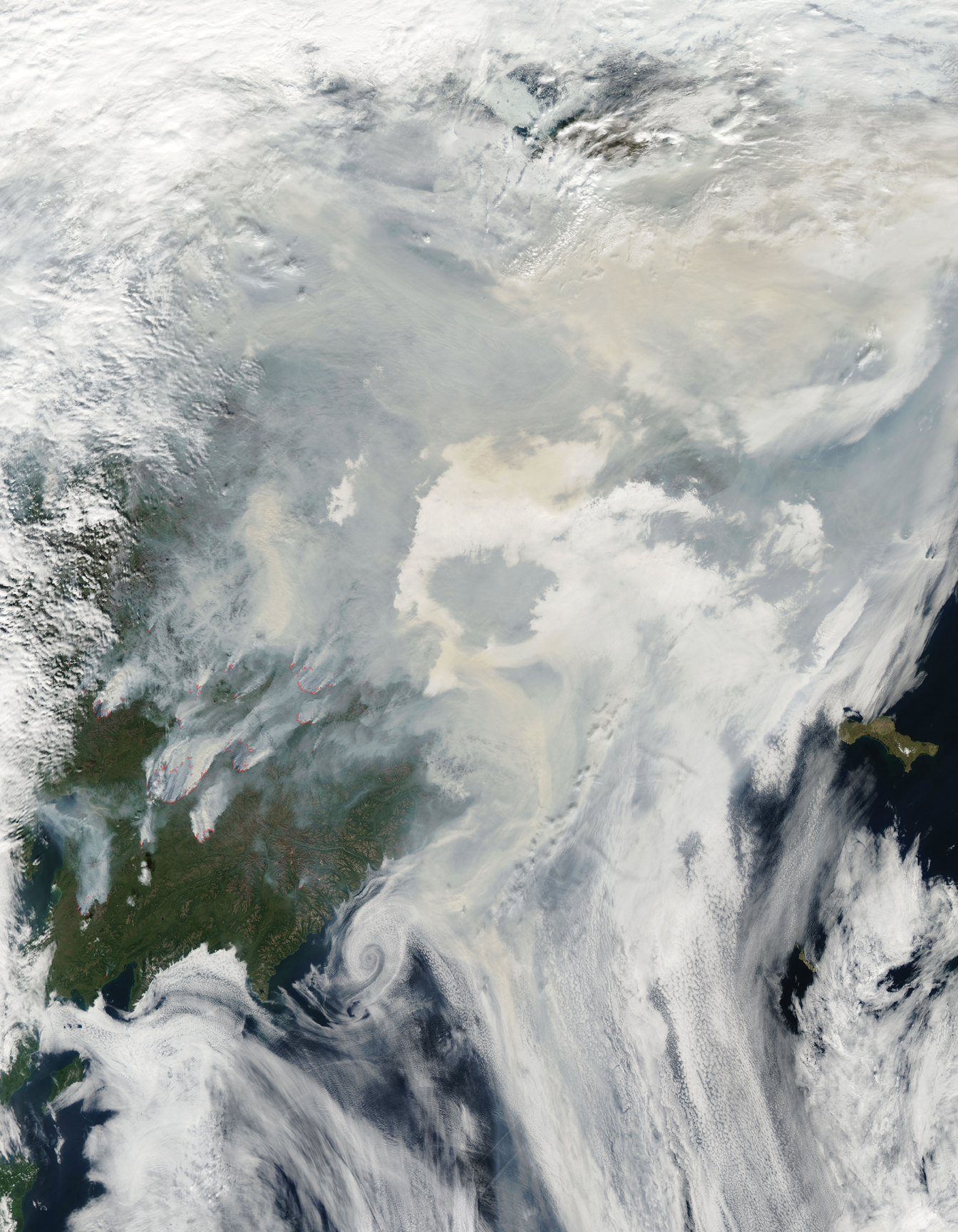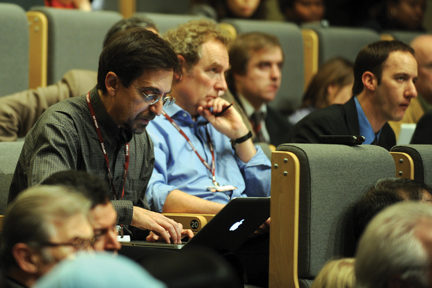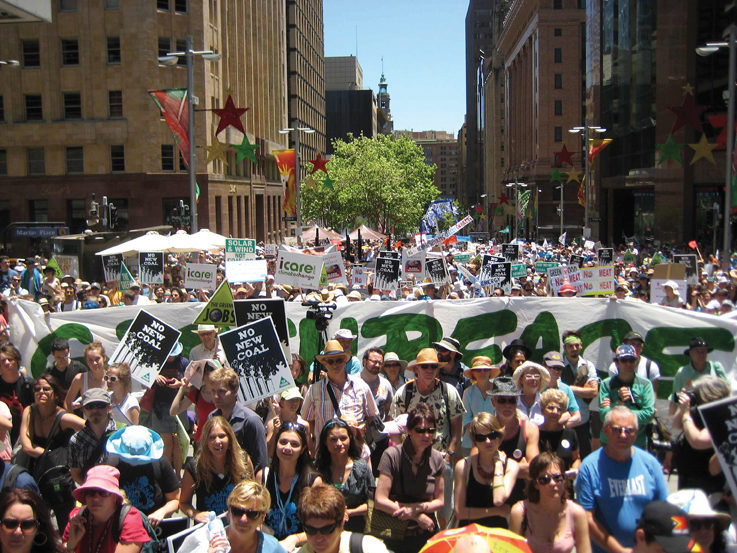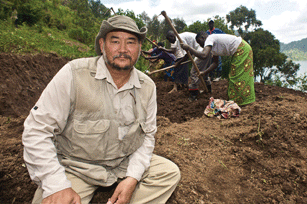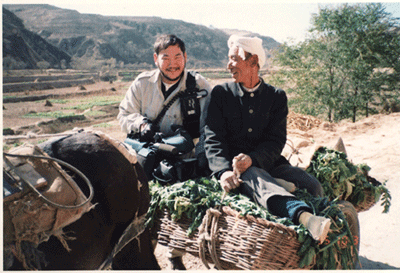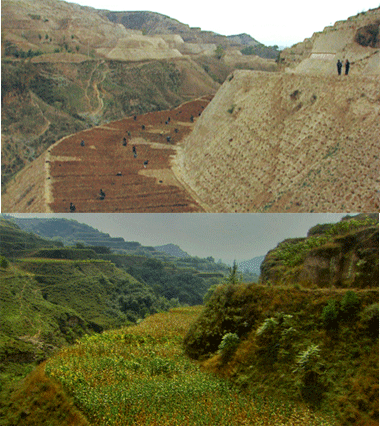
|
Published: 14 September 2010
Science, ‘Sceptics’ and Spin: Framing the climate change debate
As the world experiences its hottest year on record, hard on the heels of the world’s warmest decade, calls for urgent action by climate scientists continue to be challenged. Climate change deniers have mobilised into a vocal global movement that has become adept at misinterpreting the science and the media’s appetite for controversy. Alexandra de Blas investigates the role of scientists, deniers and the media in the public climate change debate.
In 2007, climate change was riding high in the public’s consciousness. In the Lowy Institute annual poll, Australians ranked climate change as their equal-highest foreign policy goal, with 75 per cent saying it was very important.1 This year, it ranked tenth, with a bare majority of 53 per cent saying it was a very important goal. A larger majority (72 per cent), however, agreed Australia should take action to reduce its carbon emissions before a global agreement is reached, but they weren’t prepared to invest much in achieving it.
Other pollsters have noted similar findings. Essential Media Communications has watched climate change drop from ‘the top third or fourth issue of concern last year, to a point where it’s now lucky to rate in the top ten,’ says Senior Client Manager, Shannon Walker. ‘We find climate change isn’t top of mind unless the media are talking about it.’
In the past year, debate raising doubt about global warming has spiked at both the national and global level. Political analysts have linked the dramatic fall in popularity of former Prime Minister, Kevin Rudd, partly to his announcement in April that his government would postpone a decision on emissions trading until 2013.2
In 2009, the ‘Climategate’ and ‘Glaciergate’ controversies were used by those refuting the scientific basis of climate change to discredit the Intergovernmental Panel on Climate Change (IPCC) and a key contributing scientific institution, the Climate Research Unit at the University of East Anglia. The global media campaign was sensationalist and, from the viewpoint of the scientific community, vicious.
The ‘Climategate’ affair – in which thousands of private emails between scientists were published on a Russian website – has been scrutinised by three separate inquiries (an independent panel, the UK Parliament and the University of East Anglia), each of which has cleared those involved of alleged misconduct. However, the scientists were rebuked for demonstrating insufficient ‘openness’ in regard to Freedom of Information requests.
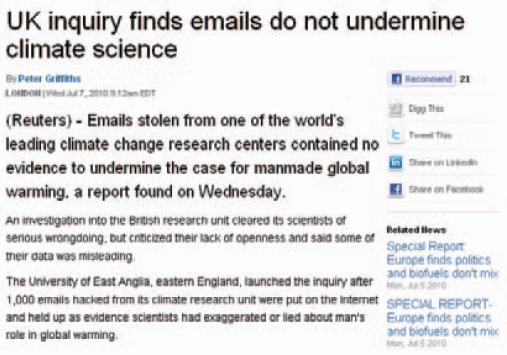
|
| Three separate enquiries have since vindicated scientists targeted by ‘Climategate’ and ‘Glaciergate’ allegations last year. |
The ‘Glaciergate’ controversy centred on a poorly substantiated claim about the melting of Himalayan glaciers quoted in one paragraph of a 938-page working paper. The IPCC has emphasised that the paper did not influence the final conclusions of its 2007 Fourth Assessment Report, and has published erratum statements on its website to clarify these minor errors.3
Meanwhile, freezing winter temperatures and cooler weather in some parts of the world over the past year, combined with the ‘weak agreement’ reached at the UN COP15 conference in Copenhagen in December, have added to public confusion.
A key issue in communicating climate change is the complexity of the science. Science is based on the premise of full disclosure and transparency. As a consequence, scientists often fare poorly in the public communication arena; their arguments tend towards complexity, their statements are highly qualified, and their specialist use of language can unintentionally convey meanings that mislead a lay audience. Media and public relations practitioners, in contrast, communicate with audiences and clients using clear, simple and consistent messages.
As renowned climate scientist, the late Professor Stephen Schneider, put it, ‘You don’t start with a level playing field, because the epistemologies of advocacy and science are so diametrical’ – referring to the fact that scientists could harm their careers by acting in the same way as their opponents.4 Should they take the risk, said Professor Schneider, it would be ‘a quick ticket to not getting funded, not getting promoted and not getting your papers accepted.’
Sceptics or contrarians?
Genuine questioning and scepticism is fundamental to the advancement of science. Australian climate scientist, Dr Barry Pittock, argues that researchers must apply their critical faculties to both sides of an argument. They must also admit uncertainties and accept that despite the existence of uncertainty, risk management may require immediate policy responses.5
He considers so-called climate change ‘sceptics’ to be more accurately defined as ‘contrarians.’ This is because unlike traditional sceptics, they are sceptical of one view – the science – while failing to challenge the contrary: their own views. Contrarians, or deniers, often employ point scoring, common in adversarial politics, which condones the selective use of evidence even when its source is dubious or its accuracy in doubt. Dr Pittock argues that such an approach is unacceptable, not only because of the selective use of data, but because of the comparative risk. If the science proved correct down the track, and the public had been dissuaded to take action, global warming could well have passed the ‘tipping point’.
Dr Pittock says that media practitioners tend to achieve their goal of objectivity and balance by giving equal space to opposing views. But, this can be misleading. In the case of climate change, a small group of climate scientists disputing the general conclusions of the IPCC Fourth Assessment have received a level of media exposure disproportionate to the number of scientists supporting the IPCC’s findings. This has created the false impression that scientists are evenly divided on the climate question.
Who are we to believe? Dr Pittock points out that arguments made in peer-reviewed, credible scientific journals are more likely to be worthy of consideration when they are up against claims made by newspaper columnists, politicians or special interest ‘think tanks’. While not perfect, the peer-review process gives the public, media and policy makers some assurance about the credibility of an argument.
A recent study investigating the question of where the scientific community stood on the threat of climate change came down on the side of consensus.6 The study categorised climate scientists as either ‘convinced’ or ‘unconvinced’ of human-made global warming. It found that 97 to 98 per cent (‘those most actively publishing in the field’) agreed with the primary conclusion of the IPCC: that anthropogenic greenhouse gases were responsible for most of the ‘unequivocal warming’ of the Earth’s average global temperature over the second half of the 20th century. The study also assessed the climate expertise and scientific prominence of the ‘unconvinced’ researchers as being substantially below that of the ‘convinced’ researchers.
In their book Merchants of Doubt, Professor Naomi Oreskes and Dr Erik Conway argue that the public’s confusion about the veracity of global warming is no accident. The authors claim that the public has been subject to a ‘systematic and organised’ campaign to spread doubt about the climate change science for 30 years.7
Rhetorical framing
Maria Taylor, from the Centre for the Public Awareness of Science at the Australian National University, has studied the way Australia’s climate debate has been ‘framed’ by the media and interest groups over the past few decades.8 Ms Taylor found that while the evidence of human-induced climate change has remained consistent since the IPCC released its first report in 1990, the way the issue has been framed in the public domain has changed dramatically over recent years.
Ms Taylor says that framing is critically important to how an issue is communicated. ‘It is not what you say that matters so much as what people “hear,”’ she says.
United States cognitive scientist, Professor George Lakoff, found that ‘rhetorical’ framing used by politicians and the media – for example, arguing against a policy by evoking a threat to ‘core values’ such as individual freedom, family, jobs, or the national interest – will influence public opinion, regardless of the evidence.9
Professor Lakoff examined how this approach was practiced by public relations professionals such as Mr Frank Luntz, who advised members of the governing Republican Party on climate change strategy. In addition to invoking core values, Mr Luntz recommended that scientific uncertainty should be exploited to promote inaction, and that people identified as scientists should promote the uncertainty discourse.
Similar trends have been observed in Australia. From her analysis of the early framing of climate change from 1987 to 1992, Ms Taylor found that scientist’s views were perceived as ‘clear and accepted’. But, as the framing of climate change shifted from the mid-1990s onwards, the public perception shifted to the view that scientists were uncertain and in disagreement about climate change.
While climate scientists may still debate issues such as degrees of impact, or timeframes, there is consensus within their community that global warming is happening and that humans are responsible. If we accept this consensus, we then need to realise that the longer we wait to act, the more the risks will increase and the fewer our options. Thus the communication challenge is clear – to convey the need for urgent action, the consequences of inaction, and pathways to a safer, more sustainable, clean energy future.
1 The 2010 Lowy Institute Poll: www.lowyinstitute.org/Publication.asp?pid=1305
2 For example, see Barrie Cassidy: www.abc.net.au/news/stories/2010/06/24/2936317.htm
3 See IPCC website: www.ipcc.ch/press_information/press_information.htm
4 AAAS 2010: www.abc.net.au/rn/scienceshow/stories/2010/2859986.htm
5 Pittock B (2009) Climate Change: The Science, Impacts and Solutions (2nd edition). CSIRO Publishing, Melbourne.
6 Anderegg WRL, Prall JW, Harold J and Schneider SH (2010). Expert credibility in climate change Proceedings of the National Academy of Sciences www.pnas.org/cgi/doi/10.1073/pnas.1003187107
7 Oreskes N and Conway E (2010) Merchants of Doubt: How a Handful Of Scientists Obscured The Truth On Issues From Tobacco Smoke To Global Warming. Bloomsbury Press.
8 Taylor M (2010). Framing climate change: how we lost 20 years on climate change action. Chemistry in Australia, reproduced in www.thefifthestate.com.au/archives/8870, http://search.informit.com.au/documentSummary;dn=303388705830167;res=IELENG
9 Lakoff G (2005). Don’t Think Like an Elephant. Scribe, Carlton North


